![]()
Smoky Mountain Rail Tour
June, 2009
Part VI - Three Rivers Flyer (Knoxville), Smoky Mountain National Park
 |
 |
 |
 |
| After a quick drive to Knoxville, TN, we board the Three Rivers Flyer along the Tennessee River. That's the University of Tennessee football stadium in the distance. This railroad offers "railgate" services to the stadium on game days. | As I often say in my captions: "This picture is for Terry & Mo, and everybody should know why". | There was a water ski exhibition taking place in the river where we boarded the train. | This was a charter train for our group only. We had full access to the open air gondola car. It was really HOT out, so the smarter folks stayed in the air conditioned cars. |
 |
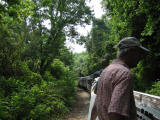 |
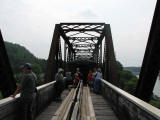 |
 |
| A bright red caboose marked the end of our train. | The train follows the Tennessee River, often making its way through dense foliage and "tree tunnels". | The train crosses the Holston River on a trestle that we can enjoy from the open-air gondola. | Views along the banks of the Holston. |
 |
 |
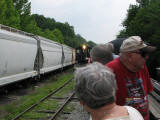 |
 |
| The Holston River (to the right) joins the French Broad River (to the left) to form the Tennessee River (which flows to the top of this picture). Now you know why this train is called the Three Rivers Rambler. | The Knoxville area has many marble stone quarries. This quarry looks a little like ancient temple ruins. | The railfans gather to photograph the locomotive as it runs around our train to reverse direction for our trip home. | `This picture contains a surprise. On the upper right trestle girder, look carefully to see an osprey nest. You can see the osprey in flight right at the nest. |
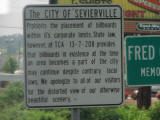 |
 |
 |
 |
| After our train ride in Knoxville, we head for Smoky Mountain National Park. On the way, we pass through Sevierville. Looks like an English teacher is needed here. (Hint: look for incorrect apostrophe use on this sign) | At the Park visitor center, we found a large bank of solar cells. I'm not sure how the power is used. | We walked a short distance from the visitor center, and the crowds thinned dramatically. | |
 |
 |
 |
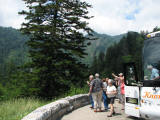 |
| On the visitor center loop trail. | The road climbs steeply to cross the Smoky Mountains. | Our bus made numerous stops on the way up so we could see the views. | Look carefully at this series of pictures, and you'll see that the conifer (fir and hemlock) trees have been severely damaged by the wooly adelgid, an aphid-like insect from Asia. In some areas of the park, the wooly adelgid has killed more than 90% of the fir. |
 |
 |
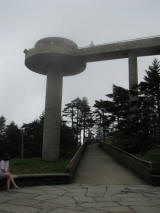 |
 |
| We're up to 4800 feet, with about 1800 feet to go to the high point of our trip today. | The highest point in the Smokies is Clingmans Dome at 6643 feet. We walk the short (1/2 mile) path to the top of the Dome. Note the severe conifer loss in this area. | A spiral ramp leads to an observation platform atop Clingmans Dome. | I spy Mo coming up the ramp. |
 |
 |
 |
 |
| Mo and David (from New Jersey) come up to the top of the platform. | From the observation platform. | Mo on the path back down with another member of our tour group. | Nobody was here to bother us today, but this sign marks the spot where groups or individuals might "express themselves". |
 |
 |
|
 |
| This is the area of the great Cherokee relocation and the Trail of Tears. There is much Cherokee history here. The right side of this information panel is written in the Cherokee language. | A close up view of the Cherokee text. | I find it impossible to capture vistas with a standard camera lens. Here is a panorama stitched together from three photographs taken from the Clingmans Dome parking lot. Notice the dark clouds hanging over the valley. | Just a few minutes later, the sky has turned considerably brighter. |
 |
 |
|
 |
| The Appalachian Trail crosses the path to Clingmans Dome. We probably won't be hiking to Katahdin Maine on this trip. | From the Newfound Gap viewpoint (elevation 5046). | A very wide angle view of Newfound Gap, stitched together from four photographs. | Looking North from Newfound Gap. |
 |
 |
 |
 |
| On our descent from the Smokies, we stop at the Mingus Mill, which is a restored, functioning grist mill. There is no wooden water wheel here - the water travels down this chute to an enclosed iron turbine. | In the (men's) restroom, complete instructions on what to do for #1 and #2. While selective flushing is new to the United States, look here or here to see this technology commonly used in New Zealand when I was there three years ago. | The Nantahala River runs right behind our motel in Dillsboro, NC. We'll be traveling along this river by train tomorrow morning. | Dillsboro town hall. |
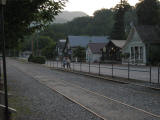 |
 |
||
| We explored the quaint town of Dillsboro as we walked back to our motel after dinner. | Walking down the tracks was the quickest way back to the motel. This is little-used, slow speed track. |